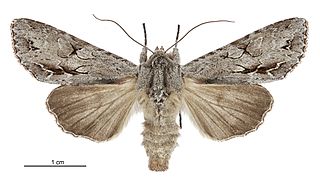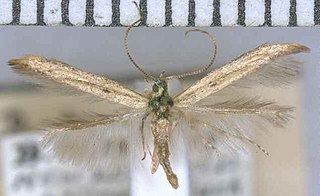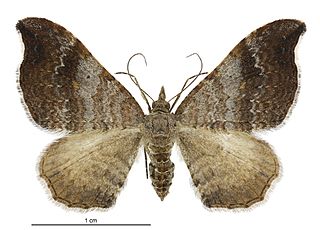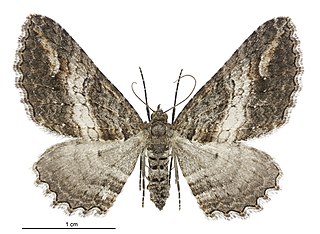
Eudonia philerga is a species of moth of the family Crambidae. This species was first described by Edward Meyrick. It is endemic to New Zealand, found throughout the country, and regarded as common. Larvae feed on moss. Adult moths have been observed on the wing more frequently from October to April, and are attracted to light.

Ichneutica insignis is a moth of the family Noctuidae. It is endemic to and found throughout New Zealand, although it appears to be scarce at inland sites of tussock grasslands. The adults are on the wing throughout the year. It is a variable species and as such can be easily confused with I. skelloni and I. plena. The larvae of this species have been recorded as feeding on Trifolium pratense.

Ichneutica ustistriga is a moth of the family Noctuidae. It is endemic to New Zealand and can be found from the Three Kings Islands to Stewart Island. This species lives in a wide variety of habitats including domestic gardens, horticultural areas, orchards, native and exotic grasslands, as well as native forest. The larvae eat a variety of herbaceous plants. Recorded food plants include Muehlenbeckia australis, Muehlenbeckia complexa, Olearia hectorii, and Plantago lanceolata. This moth has a mauvish grey wing colour and is unlikely to be confused with other species as the patterns on its forewing are distinctive. This species is on the wing throughout the year and is attracted to both sugar and light traps. Adult moths can be found at rest on fences and tree trunks during the day.

Orocrambus flexuosellus is a species of moth in the family Crambidae. It was first described by Edward Doubleday in 1843. O. flexuosellus is endemic to New Zealand. It has been recorded from the North Island, South Island and the Stewart Islands. The species' habitat consists of lowland to alpine grasslands.

Batrachedra arenosella, the armoured scale eating caterpillar or the coconut moth, is a species of moth of the family Batrachedridae. It was first described by Francis Walker using specimens collected in Auckland, New Zealand. It has been hypothesised that the New Zealand moth may contain two distinct species. As well as the moth species in New Zealand, this name has been applied, perhaps incorrectly, to moths found in India, Indonesia, the Malay Peninsula, and Réunion, as well as in Australia, from the Northern Territory and northern Queensland to New South Wales and South Australia.
Stigmella maoriella is a species of moth in the family Nepticulidae. It is endemic to New Zealand. It is classified as Not Threatened by the Department of Conservation.

Asterivora chatuidea is a moth of the family Choreutidae. It is endemic to New Zealand and has been collected in and around Dunedin. The larvae of this species are leaf miners and hosts include Helichrysum lanceolatum, Olearia quinquevulnera and Pseudognaphalium luteoalbum. Adults of this species has been recorded as being on the wing in November, January and February.

Izatha attactella is a moth of the family Oecophoridae. This species is endemic to New Zealand, where it is known from both the North and South Islands as far south as mid-Canterbury. Larvae of this species feed on the soft inner surface of the bark of dead trees and shrubs. Adults have been recorded from September to December.

Izatha copiosella is a moth of the family Oecophoridae. It is endemic to New Zealand, where it is found on the south-eastern parts of the North Island and throughout the South Island except the West Coast. Larvae are found in dead wood and are likely to use kōwhai species as hosts. The adults are night fliers and are attracted to light. They are on the wing in January and February.

Eudonia submarginalis is a species of moth in the family Crambidae. It was described by Francis Walker in 1863. It is endemic to New Zealand.

Pasiphila bilineolata is a moth in the family Geometridae. It is endemic to New Zealand and can be found in the North and South Islands. The species inhabits native forest and shrubland and the larvae feed on Hebe species. Adults are on the wing commonly from August to January but have been observed most months of the year and are attracted to light.

Pasiphila cotinaea is a species of moth in the family Geometridae. It is endemic to New Zealand. Its larvae feed off Olearia species and the adult moth can be seen on the wing from November to April. This species is regarded as rare.

Homodotis megaspilata, also known as the small hooked-tip looper moth, is a moth of the family Geometridae. It is endemic to New Zealand and can be found throughout the country. It is regarded as being common species. The preferred habitat of this species is native forest, scrub, coastal areas and domestic gardens. Larvae feed on the dead leaves of Geniostoma ligustrifolium and likely other native plants. Once mature the larvae will pupate on the ground forming a silken cocoon protected by hiding inside two leaves of its host plant. Adults are nocturnal and are on the wing from October to April. They are attracted to light. In appearance the adults of this species are extremely variable but can be distinguished from similar species as all variations have forewings with blunt hook shaped tips.

Agriophara colligatella, also known as the Olearia Skeletoniser, is a moth of the family Depressariidae. It is endemic to New Zealand and is found on both the North and South Islands. This species inhabits native scrub. Larvae feed on the leaves of species in the genus Olearia during the months of November and December. They then pupate amongst the old flowers and leaves of their host plant. Adults have been observed on the wing from August to September but are most common in January. It has been hypothesised that this species overwinters as an adult as it has been observed on the wing in late autumn and early winter. Adults are attracted to light.
Eudonia linealis is a species of moth in the family Crambidae. This species is endemic to New Zealand. It is classified as "Data Deficient" by the Department of Conservation.

Notoreas perornata is a species of moth in the family Geometridae. It is endemic to New Zealand and is found in the North Island from Northland to Westland as well as in the South Island on the coast of Marlborough.

Ichneutica disjungens is a moth of the family Noctuidae. This species is endemic to New Zealand and can be found on the central volcanic plateau of the North Island and in the eastern as well as the south western parts of the South Island. I. disjungens inhabits tussock grasslands in the alpine and subalpine zones. The hosts of the larvae of this species include Poa cita, P. colensoi, and Festuca novae-zelandiae. The adults of this species are distinctive and are unlikely to be confused with other species. They are on the wing between October and March.

Helastia semisignata is a moth of the family Geometridae. This species is endemic to New Zealand and is only found in the North Island. The life history of this species is in need of further investigation as sources differ about what plants host the larvae. Adults are on the wing commonly from October until March.

Horisme suppressaria is a moth of the family Geometridae. This species was first described by Francis Walker. Currently the taxonomy of this species is uncertain and as a result this species is also known as Horisme (s.l.) suppressaria. The species is endemic to New Zealand and has been observed in both the North and South Islands. The larval hosts of H. suppressaria are species in the genus Corokia including Corokia cotoneaster.

Orthenches disparilis is a moth of the family Plutellidae. This species was first described by Alfred Philpott in 1931. It is endemic to New Zealand and has been observed in Auckland and Otago. O. disparilis is associated with species in the genus Corokia and larvae are known to feed on Corokia buddleioides. The larvae mine the leaves and feeds on the shoots and fruit of their host. Adults are on the wing in January. Dracophyllum bushes are used as over wintering sites by the adults.


















